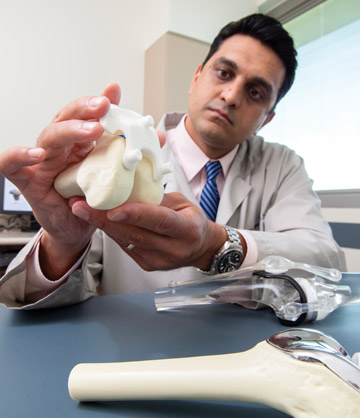We've made tremendous progress in rehabbing and recovering outpatient hip and knee replacement patients. In the not too distant past, total joint patients could expect an inpatient hospital stay of two to three nights, after which they might be discharged to an inpatient rehabilitation facility before returning home. Numerous innovations — from app- and tablet-based home rehab programs to improved surgical techniques and robotic-assistance platforms — have let us reduce that time span. Patients who undergo surgery in the morning are up and walking within an hour of leaving the operating room and heading home that same afternoon. Rapid recovery, minimal pain and a quick return to a joint's prior level of function are hallmarks of our outpatient total joint service line, which requires a collaborative effort among all members of the patient care team and involves tapping into technology that helps patients return to normal life activities sooner.
- Home-based recovery. Digital rehab platforms have great potential because they can lower the touchpoint barrier for more frequent interaction between provider and patient, allowing patients to participate more and receive more feedback during rehab. These technologies use various devices — including patients' smartphones and tablets as well as in-home, connected rehabilitation devices — to educate and coach patients through rehab activities, record exercise data that clinicians can view and analyze, and provide telehealth capabilities.
Plus, technologies like accelerometers can relay how many steps the patient is taking, or how much their knee is bending, and automatically send alerts to a provider's phone. Interactive rehab technologies also cut costs and save time for providers and patients alike by enabling patients to rehab at home, at their own convenience, as opposed to traveling to appointments with a physical therapist.
- Surgical techniques. The minimally invasive techniques we use are muscle-sparing approaches, meaning the major muscles are retracted as opposed to cut. This allows for faster healing with less inflammation and pain, resulting in a more rapid return to function.
You don't want to perform a minimally invasive operation that may have a more limited field of view if that ultimately doesn't allow for the implant components to be put in the right position. At the same time, you want to get the patient up and moving more quickly and avoid cutting important muscles, tendons and other structures solely for the sake of visualization. That's where technologies like patient-specific instrumentation for knee replacement come into play.
Well in advance of surgery, we use a combination of imaging modalities, including X-rays and MRI, to generate a computerized model of the knee. We then plan the entire surgery virtually well before making an incision. This work allows us to accurately size the implants, precisely plan bone cuts and create a game plan for the operation.
.svg?sfvrsn=be606e78_3)

.svg?sfvrsn=56b2f850_5)